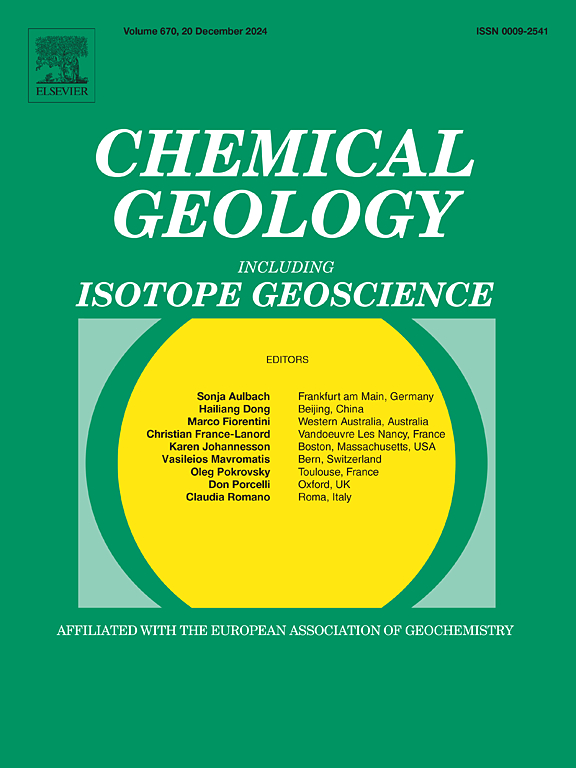Samail蛇绿岩中的海洋蛇纹石化:来自微量元素和O和B同位素的证据
IF 3.6
2区 地球科学
Q1 GEOCHEMISTRY & GEOPHYSICS
引用次数: 0
摘要
海洋蛇纹石作用代表了水圈和岩石圈之间的主要联系,含水流体通过水热作用改变地幔岩石。对以前的海洋岩石圈的研究,现在在构造上安置在陆地上,可以作为一个有用的模拟现代过程。在这项研究中,我们展示了来自Samail蛇绿岩的蛇纹橄榄岩的地球化学组成,这是一个活跃于新特提斯的快速扩张脊轴,在Sumail和Wadi Tayin地块中。利用蛇纹石的流体流动元素(FME)组成以及O、B和Sr同位素的组合来破译蛇纹石成矿流体的来源,这将限制蛇纹石成矿的位点(即洋域、逆冲期间和侵位后)。原位分析显示,蛇纹石FME含量为0.2 ~ 27.7 μg−1 B, 0.1 ~ 10.7 μg−1 Sr, 600 ~ 1800 μg−1 Cl;δ18O值高变异性(+1.3 ~ +8.1‰);δ11B值在+33 ~ +41‰之间,δ11B值在+2 ~ +47‰之间。将这些数据与蛇纹石成矿流体潜在来源(如海水、热液蚀变流体、俯冲板块衍生流体、大气水)的地球化学特征进行比较后,未能提供任何表明俯冲板块衍生流体或大气水导致蛇纹石成矿的证据。相反,蛇纹岩的地球化学特征表明,蛇纹岩化最可能发生在靠近扩张脊轴的海底,在与上覆海洋地壳相互作用后,与海水和热液蚀变流体发生反应。此外,某些样品中测量的δ11B范围可以根据封闭系统中相对较低温度下的两步蛇纹石化历史来建模,由δ18O值计算(从115°C到250°C)。该研究证明了结合多种原位地球化学工具来追踪蛇纹岩化历史的有效性,特别是在可能发生多次热液蚀变的倒伏蛇绿岩中。本文章由计算机程序翻译,如有差异,请以英文原文为准。
Oceanic serpentinisation in the Samail ophiolites: evidence from trace elements and O and B isotopes
Oceanic serpentinisation represents a major link between the hydrosphere and the lithosphere, whereby aqueous fluids hydrothermally alter mantle rocks. The study of former oceanic lithosphere, now tectonically emplaced on land, can serve as a useful analogue to modern processes. In this study, we present the geochemical composition of serpentinised peridotites from the southern Samail ophiolites, a fast-spreading ridge axis active in the Neo-Tethys, in the Sumail and Wadi Tayin massifs. The combination of the fluid-mobile element (FME) composition, as well as O, B and Sr isotopes, of serpentine is utilised to decipher the source of the serpentinising fluid, which would constrain the loci of serpentinisation (i.e., oceanic domain, during obduction, after emplacement). The in situ analysis of the serpentine revealed FME contents ranging from 0.2 to 27.7 μg g−1 B, 0.1–10.7 μg g−1 Sr, and 600–1800 μg g−1 Cl; high variability in δ18O values (+1.3 to +8.1 ‰); and δ11B ranging from +33 to +41 ‰ in one sample, and between +2 and +47 ‰ for two others. A comparison of the data with the geochemical characteristics of potential sources of the serpentinising fluid (e.g., seawater, hydrothermally-altered fluid, subducted-slab-derived fluid, meteoric water) has failed to provide any evidence indicative of serpentinisation with subducted slab-derived fluid or meteoric water. Conversely, the geochemical characteristics of serpentine indicate that serpentinisation most likely occurred on the ocean floor in proximity to the spreading ridge axis, subsequent to reaction with seawater and hydrothermally-altered fluid following interaction with the overlying oceanic crust. Furthermore, the range of measured δ11B in certain samples can be modelled on the basis of a two-step serpentinisation history in a closed system, at relatively low temperatures, calculated from the δ18O values (from 115 to 250 °C). This study demonstrates the efficacy of combining multiple in situ geochemical tools to trace the history of serpentinisation, particularly in obducted ophiolite where hydrothermal alteration may could have occurred on multiple occasions.
求助全文
通过发布文献求助,成功后即可免费获取论文全文。
去求助
来源期刊

Chemical Geology
地学-地球化学与地球物理
CiteScore
7.20
自引率
10.30%
发文量
374
审稿时长
3.6 months
期刊介绍:
Chemical Geology is an international journal that publishes original research papers on isotopic and elemental geochemistry, geochronology and cosmochemistry.
The Journal focuses on chemical processes in igneous, metamorphic, and sedimentary petrology, low- and high-temperature aqueous solutions, biogeochemistry, the environment and cosmochemistry.
Papers that are field, experimentally, or computationally based are appropriate if they are of broad international interest. The Journal generally does not publish papers that are primarily of regional or local interest, or which are primarily focused on remediation and applied geochemistry.
The Journal also welcomes innovative papers dealing with significant analytical advances that are of wide interest in the community and extend significantly beyond the scope of what would be included in the methods section of a standard research paper.
 求助内容:
求助内容: 应助结果提醒方式:
应助结果提醒方式:


